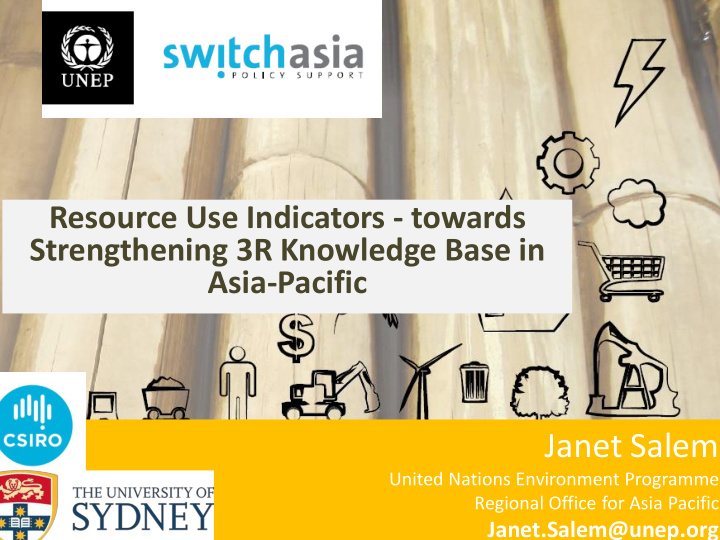



Resource Use Indicators - towards Strengthening 3R Knowledge Base in Asia-Pacific Janet Salem United Nations Environment Programme Regional Office for Asia Pacific Janet.Salem@unep.org
Resource Use Indicators - towards Strengthening 3R Knowledge Base in Asia-Pacific Janet Salem UNEP, Regional Office for Asia Pacific Janet.Salem@unep.org
United Nations Environment Programme The leading global environment authority that sets the global environmental agenda. Mission: “To provide leadership and encourage partnership in caring for the environment by inspiring , informing , and enabling nations and peoples to improve their quality of life without compromising that of future generations.” Climate change, • Disasters and conflict, • Ecosystems management, • Environmental governance, • Harmful substances and hazardous waste, • Resource efficiency – sustainable consumption and • production Environment under review •
What are natural resources? Natural resources are the physical basis of our social and economic activities. Materials Energy Water Emissions Biomass Coal Groundwater Air emissions (crops, animal Renewables Freshwater Water + forest emissions Oil Rainwater products) Waste Gas Fossil Fuels emissions Nuclear Construction minerals Metal ores *Land is another resource, but is not in scope of our report
What are natural resources? Natural resources are the physical basis of our social and economic activities. Materials Energy Water Emissions Biomass Coal Groundwater Air emissions (crops, animal Renewables Freshwater Water + forest emissions Oil Rainwater products) Waste Gas Fossil Fuels emissions Nuclear Construction minerals Metal ores *Land is another resource, but is not in scope of our report
What are natural resources? Natural resources are the physical basis of our social and economic activities. Materials Energy Water Emissions Biomass Coal Groundwater Air emissions (crops, animal Renewables Freshwater Water + forest emissions Oil Rainwater products) Waste Gas Fossil Fuels emissions Nuclear Construction minerals Metal ores Hydrosphere Atmosphere *Land is another resource, but is not in scope of our report
Global environmental agenda in resource use Priorities for Asia Pacific: • Address climate change and enhance resilience • Decouple economic growth from resource use and pollution • Maintain biodiversity and sustainable provision of ecosystem services • Manage Chemicals and Waste • Use the Sustainable Development Goals to scale up environmental action • Environment and Health, especially Air Quality • Science-Policy Linkages
Global environmental agenda in resource use Sustainable Development Goals Goal 8. Promote sustained, inclusive and sustainable economic growth, full and productive employment and decent work for all 8.4 improve progressively through 2030 global resource efficiency in consumption and production, and endeavour to decouple economic growth from environmental degradation… Goal 12. Ensure sustainable consumption and production patterns 12.2 by 2030 achieve sustainable management and efficient use of natural resources
Global environmental agenda in resource use But how do we get there?
Indicators for Resource Efficiency • Inform about issues and trends • Help agenda setting • Informed public debate • Underpin policy goals and policy statements in the form of targets • Measure progress in achieving policy objectives
Indicators for a Resource Efficient Green Asia Pacific Natural Resource Trade Use Dependency Resource Eco-efficiency Productivity of Production Adjusted Consumption Resource Productivity Economic Growth and Human Development
#1 - Natural Resource Use What is it? Total amount of natural resource use and natural resource use per capita Policy Use? Evidence base for decoupling policies. Show the physical scale of the economy. Indicators? Domestic Material Consumption (tonnes) Total Primary Energy Supply (joule) Total Water Use (m 3 ) Greenhouse Gas Emissions (tonnes)
#1 - Natural Resource Use
#1 - Natural Resource Use PR - Industrialised Resource China use Japan per capita Philippines varies in -Developing amount and rate of growth the region
#2 - Trade Dependency What is it? Dependence on natural resources from global markets. Policy Use? Importers: tracking resource efficiency to reduce economic dependency from trade Exporters: mitigating negative side effects of a trade based primary resource economy to allow for better distribution and use of primary resource incomes Indicators? Physical Trade Balance (tonnes) Unit Price of Trade ($/kg) Imports/Exports (tonnes)
#2 - Trade Dependency
#3 - Resource Productivity What is it? Economic output per unit of natural resource input Policy Use? Important for developing countries increasing their resource base to support human development and material standards of living. This becomes particularly important when Asian economies depend more on natural resource imports and global resource prices are rising. Indicators? Material Productivity ($/kg) Energy Productivity ($/joule) Water Productivity ($/m3) GHG Intensity ($/kg)
#3 - Resource Productivity Material use per dollar of GDP Viet Nam PR China India Fiji Japan
#4 - Eco-Efficiency of Production What is it? Total sectoral resource use, and sectoral resource productivity Policy Use? Allows setting targets and establishing policies for different economic activities and will have a much greater steering effect than national targets would have. Because they are close to the activities they would drive innovation and best practice in economic sectors. Indicators? Water Use in Agriculture (m3) Emissions of the Energy Sector (tonnes) Material Use for Manufacturing (tonnes) Material Use for Construction (tonnes) Emissions of Transport (tonnes) Material Footprint of Services (tonnes)
#4 - Eco-Efficiency of Production
#5 - Consumption What is it? Natural Resource Footprint. Attribution of natural resource use to final consumption. Policy Use? It ‘corrects’ for upstream requirements of imports and exports. For high importing and exporting countries this will allow an ‘equal playing field’ regardless of economic structure and role in the global economy. Indicators? Material Footprint (tonnes) Energy Footprint (joule) Water Footprint (m3) Carbon (GHG) Footprint (tonnes)
#5 - Consumption
Resource use in Asia-Pacific Material use in the Asia Pacific region 40,000,000,000 35,000,000,000 30,000,000,000 25,000,000,000 Tonnes Production 20,000,000,000 Extraction 15,000,000,000 Consumption 10,000,000,000 5,000,000,000 0 1970 1973 1976 1979 1982 1985 1988 1991 1994 1997 2000 2003 2006 2009 Production : Domestic Material Consumption (imports + extraction – exports) Consumption : Material Footprint Extraction : Mining, Agriculture
Communicating is important!
More information: http://www.unep.org/AsiaPacificIndicators Janet Salem United Nations Environment Programme Regional Office for Asia Pacific Janet.Salem@unep.org
Recommend
More recommend